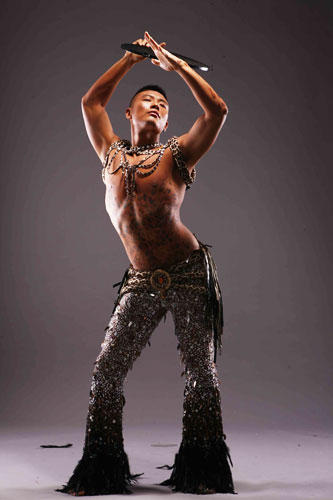Profiles
Boys who belly dance
By Cheng Anqi (China Daily)
Updated: 2011-05-15 11:23
 |
Large Medium Small |
 |
Related story: Pole dancing shakes off ill repute in China
Pole dancing shakes off ill Usually, it is seductive sirens who sashay to the mesmerizing moves of belly dancing. In China, however, the art takes on a very different flavor when it is the male dancers who shimmy on the floor. Cheng Anqi finds out more.
Guo Wei is a male belly dancer. Not only that, he is one of Beijing's most well-known practitioners of the Middle Eastern dance form, and he also claims the honor of being the first to turn professional.
He's now 33, and he still remembers how hard it was for him when he started dancing 13 years ago. "When I first saw belly dancing on television, I became enthralled by Middle Eastern culture," says Guo, who was working as a gym coach and a dance instructor teaching hip-hop and pop.
He was so fascinated that he decided to study with the Egyptian Royal Belly Dancing College in Turkey, after which he performed in the United States and many European countries.
When he came back to China, he founded the Guo Wei Belly Dancing Studio at Jianwai Soho.
"When belly dancing first made its way to Beijing in the early 2000s, most people were not receptive to the seemingly sexual moves," he recalls. To circumvent that sensitivity, Guo adjusted the mode of his lessons, starting with aerobics and gradually incorporating belly-dancing moves into the regime.
"If it was a 15-minute session, I would introduce 5 minutes of belly-dance moves, like hip drops. When the students got used to that, I added more and then they fell in love with the dance," Guo says.
It was not just the girls who were responding to the new dance form. The men, too, were gyrating to the Arabian melodies and mastering the sinuous moves, doing it all so well sometimes that it shamed the women.
Aleksandra Shilnikova is still amazed by Guo's combination of muscular stature and seductive moves. She is a Russian expatriate working with a foreign trading company in Xiamen, Fujian province and she had come all the way to Beijing to Guo's studio to pursue her love for belly dancing.
She was initially shocked by what she saw.
"His hip drops were explosive and full of passion, and he reminded me of trainers in the West with his remarkable dedication and energy," says the 26-year-old.
"Men prefer the straightforward approach and Guo gets to the point and make sure every student understands it," says Shilnikova.
She adds that Guo is very vigorous and he keeps the girls invigorated even when they no longer have the stamina to go on. She finds her Chinese classmates very motivated, and they put great effort into their practice although she observes that cultural differences set them apart as well.
"While Western dancers emphasize more on self-expression, the Chinese prefer to focus on fixed dance steps. But, they are getting more receptive and open."
Han Weisong is one of two male assistant teachers at Guo's studio, and he says his entry into belly-dancing was due to a simple twist of fate.
Two years ago, the 22-year-old was working as a hotel cook in Inner Mongolia when he came up with the idea of performing a belly dance for the company's annual dinner celebration.
He had no idea how to go about it, so he found some belly-dancing videos and started imitating the moves. That was the beginning of a long love affair with the art.
But Han was making up his own moves and he had no formal training. He decided to travel to Beijing to learn from Guo.
For Guo himself, his current mission is to improve the image of belly dancing, and to protect the reputation of his beloved art.
He no longer accepts invitations to perform professionally at bars or nightclubs and his studio is now totally dedicated to teaching belly dancing.
There is plenty still to do.
"We need publicity and reorganization," Guo declares. "But I cherish my reputation and I do not want belly dancing to be misunderstood."
The same lack of understanding plagued Wen Kexin when she introduced belly dancing to Beijing around eight years ago. The prejudices were so strong then that reports in the media avoided mentioning "belly dance" and circumvented by substituting the word with "waist dance" or "Oriental dance".
"Even the local authorities refused to issue a business license for my dance club, because the word 'belly' was deemed a sensitive term at that time," says Wen, 28.
Today, belly dancing is no longer associated with sleazy night-club performances with all-male audiences. Instead, it has earned its rightful position as an art, a lifestyle choice and a regular fitness option at gyms and dance schools.
It is accorded a respect long overdue for a dance form with a history of more than 3,000 years. In times past, belly dancing was very much part of Arabian culture, and the dancers were female artistes who performed exclusively for royalty, and never in public.
Wen has also come a long way from her first encounter with belly dancing after she graduated from the Wuhan Conservatory of Music in Hubei province in the late 1990s.
She fell in love with the art while furthering her studies at Istanbul's Bilgi University. After five years studying with various masters all over the world, she started her first dance studio at Beijing's World Trade Center in 2002.
Now, members of Beijing's white-collar tribe flock to her waist-slimming belly dance classes, and they are not alone. Wen is now the proud owner of 48 belly dance studios nationwide as the trend spreads beyond the capital and mesmerizes the whole country.